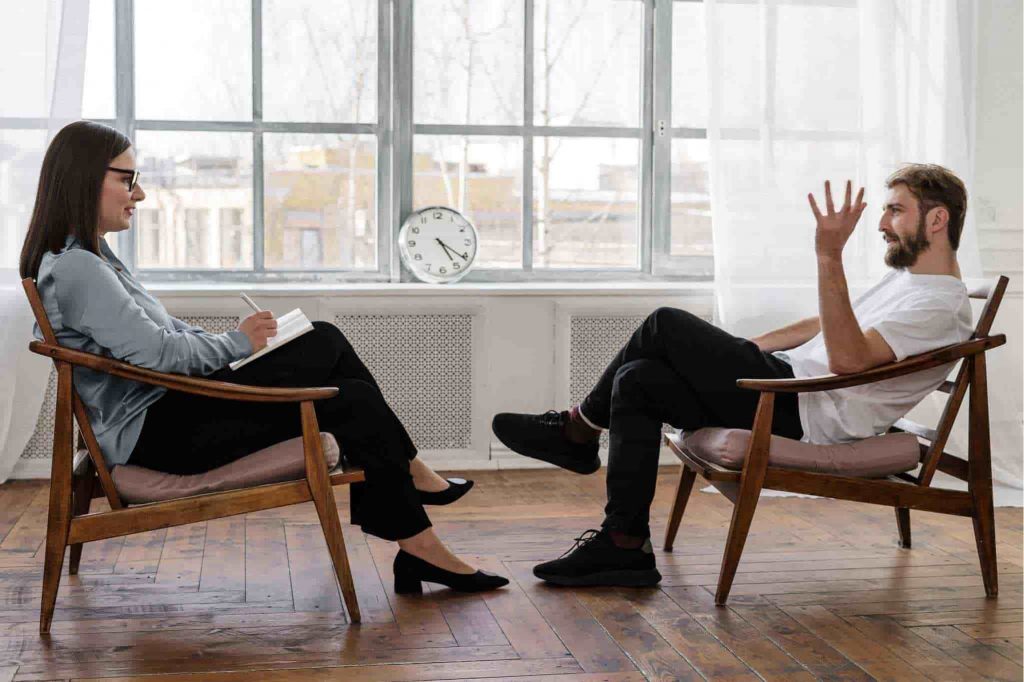Mini-Guide To Collaborative Therapy: Types, Benefits, How It Works, And More

Developed by psychologist Harlene Anderson, Collaborative Therapy is a client-centered therapy approach that focuses on creating a collaborative, integrative, and respectful therapeutic alliance between the therapist and the client to facilitate positive change.
Collaborative therapists aim to form a partnership with the client to empower them in overcoming their problems. The client and the therapist work together to set common therapy goals and identify ways to achieve said goals.
The foundation of collaborative therapy is based on the belief that knowledge is fluid and can further individual growth when the conversation happens through dialogue, not direction. In collaborative counseling, the therapist and the client’s views are equal. This collaborative approach works well with individuals who have trouble trusting authority figures.
According to Harlene Anderson, collaborative therapy is more than just a therapeutic model, it’s a philosophical concept. Let’s explore further what collaborative therapy is, its types and techniques, its benefits, and how to get started with collaborative therapy.
The Types Of Collaborative Therapy

Since collaborative therapy is more philosophical than theoretical, there are no specific types of approaches. However, there are some types of collaborative therapy that you can find associated with humanistic psychotherapy, which is another person-centered approach.
There are two types of collaborative therapies:
- Client-Centered Collaborative Therapy: In client-centered therapy, the client is the one who drives the topics of discussion and will decide what issues to address. In this type, it’s the client who works with the therapist to prioritize their concerns, issues, and goals.
- Therapist-Centered Collaborative Therapy: In therapist-centered therapy, it’s the therapist who’s actively involved in the sessions instead of the client. The therapist is the one who decides what issues to address and what experiments to devise.
Collaborative Therapy Techniques
1. Mutual Partnership: In this, the client and therapist work mutually with honesty, empathy, and respect to share concerns for the client to grasp the full extent of their issues.
2. Rational Expertise: Here, the therapist listens actively to the client and their experiences to make the therapy more effective. The client is the expert here when it comes to their experiences so the therapist must also be an expert in listening to the experiences.
3. Not-Knowing: The client is the only one who understands what it’s like to be in their shoes. This technique of collaborative therapy demands postponing judgment, taking time to understand all aspects of the problem, and allowing the client to set the goals for the sessions.
4. Being Public: In this, the therapist is open about their thoughts and feelings so the client is always aware of what’s going on in the therapist’s mind. This includes diagnosis, thoughts, judgments, and hypotheses made by the therapist. This is, however, not the same as disclosure. This is more about sharing thoughts with the client as therapy continues.
5. Living With Uncertainty: Here, the therapists are not expected to have answers to all problems. Instead, they must be living with uncertainty, meaning that they should focus on the present (what’s happening right now) rather than feeling the need to guide the therapy process.
6. Transforming Together: While therapy is an active process, here, the client and the therapist are expected to constantly work with each other to transform individually and together (the therapeutic relationship).
7. Orientation: In this technique, it is believed that therapy is a replica of outside life rather than a different space. Here, the therapist helps the client find different ways to orient themselves in their daily life rather than depending on the therapy for transition to outside life.
Collaborative Therapy Can Help With…
Collaborative therapy is not specifically designed for treating a disorder but instead is a transformation method that can be applied to any problem the client is struggling with. Instead of focusing on treating a specific problem, collaborative therapy works on helping the client become self-aware of how they think about their issues. This can later help them take control of their behaviors and feelings.
Collaborative therapy can be helpful for anyone who hasn’t had success with previous therapy experiences, mostly because of a lack of trust between the therapist and themselves.
Here are some benefits of the collaborative therapy approach:
1. Client’s Experiences Are Valued: While therapists should be considered an expert, here, the client and their past experiences are valued more than the therapist’s. Here, the client contributes to the therapy dialogue because it is believed that clients know about their problems better than anyone, even therapists.
2. Client Has Insight: As the collaborative therapy sessions move forward, the client and the therapist work together as a unit to solve the problem. When the therapist and the client work together, they gain insight into the issues and together they identify the changes in the client that lead to success in the future.
3. Client Engagement Is Greater: The client is not just a passive participant, they become a partner in the therapy. They are not the ones who stay still and do what they are told instead by being involved in the therapy process, they become an active participant and feel motivated to change their status quo.
4. The Client Has Power: Collaborative therapy approach empowers the client. The focus of this therapy approach is on helping the client learn skills they can use after the sessions are over and when they orient themselves to the outside world.
Clients, when they take an active role in the therapeutic process, contribute greatly to solving their problems and making the changes they need. With this approach, they are more likely to follow through with challenging therapy homework.
How To Get Started With Collaborative Approach?

While the benefits of collaborative counseling are suitable for any individual, there’s a chance that this client-centered approach may not be the right one for everyone. People who like a structured approach or a directive approach (where the therapist is more directive) may not find collaborative therapy well.
It can also be quite difficult to understand whether or not the therapist adheres to the principles of collaborative therapy as there are no manuals or set guidelines for this approach.
If you’re comfortable with the collaborative therapy approach then here are some steps to help you get started:
- Find A Therapist: Collaborative therapists can’t be found through generic advertisements, per se. To get started, you can approach your mental healthcare professional and ask them about their therapeutic approach. Also, make sure to check them for their qualifications, licenses, certifications, and whether or not they accept insurance.
- Show Up For Your Appointment: For your first appointment, you can talk about your goals and therapy expectations with the therapist. If your therapy is online, then be prepared for a video session. You can work on what to discuss and share with the therapist before booking your first appointment. Make sure you talk about everything you want out of the therapy session in the first appointment.
Is Collaborative Therapy Effective?
Collaborative therapy is a more philosophical concept with an open structure rather than a set of therapeutic techniques to follow. Given that this approach is more open, the methodology followed can vary depending on the therapist-client relationship.
Collaborative therapy is more about having the client and the therapist work together to achieve common therapy goals and expectations. The emphasis of a collaborative approach is on having honest, respectful, and empowering dialogue that flows naturally between the therapist and the client.
Book Your Therapy Appointment Here
I hope this article helped you understand what collaborative therapy is, the types and techniques, and its benefits. For more, you can write to us at info@calmsage.com or drop us a message on our social media. You can also share your thoughts with us in the comments below.
Take Care!




















